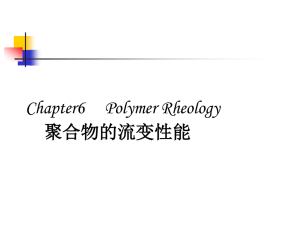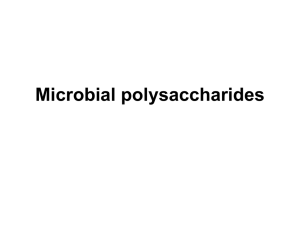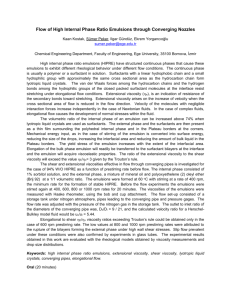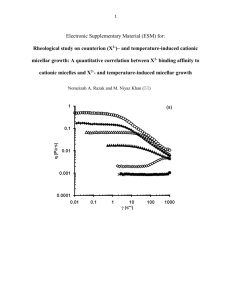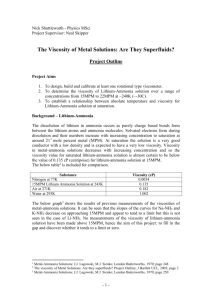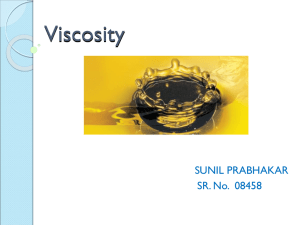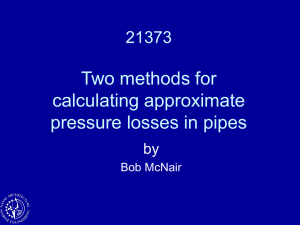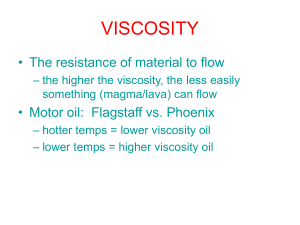Viscometry
advertisement
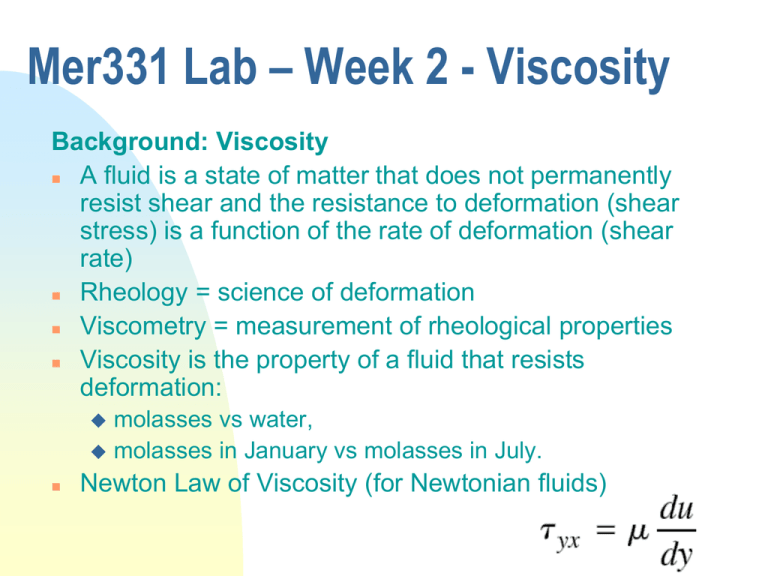
Mer331 Lab – Week 2 - Viscosity Background: Viscosity A fluid is a state of matter that does not permanently resist shear and the resistance to deformation (shear stress) is a function of the rate of deformation (shear rate) Rheology = science of deformation Viscometry = measurement of rheological properties Viscosity is the property of a fluid that resists deformation: molasses vs water, molasses in January vs molasses in July. Newton Law of Viscosity (for Newtonian fluids) Background: Viscosity Shear Thickening Shear stress as a function of deformation Background Oobleck: shear thickening http://io9.com/5715076/non+newtonian-fluids-theweirdest-liquids-youve-ever-seen http://en.wikipedia.org/wiki/Bartholome w_and_the_Oobleck http://www.youtube.com/watch?v=yHlAcASsf6U Background Ketchup, Toothpaste: shear thinning Leaping Shampoo! Versluis M, Blom C, Meer D, Weele K, Lohse D (2006) Leaping Shampoo and the Stable Kaye Effect. Journal of Statistical Mechanics: Theory and Experiment 2006P07007. http://www.youtube.com/watch?v=GX4_3cV_3Mw Background: Viscosity Units Absolute (or Dynamic) Viscosity, Units: 1 Poise = 1 g/(cm sec) 1 Pa sec = 1 kg/(m sec) = 1 N sec/m2 1 Poise = 100 cP = 0.1 Pa sec Kinematic Viscosity: = /ρ Units: 1 stoke = 1 cm2/sec = 0.0001 m2/sec Techniques for Measuring Viscosity Capillary Viscometers Rotary Viscometers Falling “Object” Viscometers And many others…. Capillary Viscometers Capillary Viscometers Measure the flow rate of a fixed volume of fluid through a small orifice From laminar flow theory we can relate the flow rate, pressure drop to viscosity = K*time K is a calibration constant Time is measured in seconds is given in cSt Rotary Viscometers Use the torque on a rotating shaft to measure a fluids resistance to flow = F * torque F is a calibration constant which you look up in the instrument manual Falling “Object” Viscometers Apply F=ma At terminal speed a=0 FG = FB + FD FB= Buoyancy FD =Drag FG = mg = rpD3g/6 FB = rfluidpD3g/6 The drag on a sphere depends on the flow field: …. FG = Weight Falling “Object” Viscometers The drag on a sphere depends on the flow field: Reynold’s Number: rVD Re = For Stokes Flow: Re < 0.1 F Drag Therefore: gD2 = rB r f 18V 3pDV = Re Restrictions: terminal velocity, Re < 0.1 Gilmont Viscometer = Kt(rball-rfluid) K = 35 Rball,ss = 8.02 (gm/ml) Rball,glass = 2.53 (gm/ml) in Cp t in minutes Lab Write Up You will write a full lab report. Review the information on the course webpage: http://engineering.union.edu/~andersoa/mer331/MELabReports.htm Include detailed information on the uncertainty analysis: Table of uncertainty values for each thing you measure (i.e. mass, volume etc). Report all data with an uncertainty value Include (hand written) derivation of uncertainty equations with a sample calculation in an appendix. See handout on lab report expectations.

